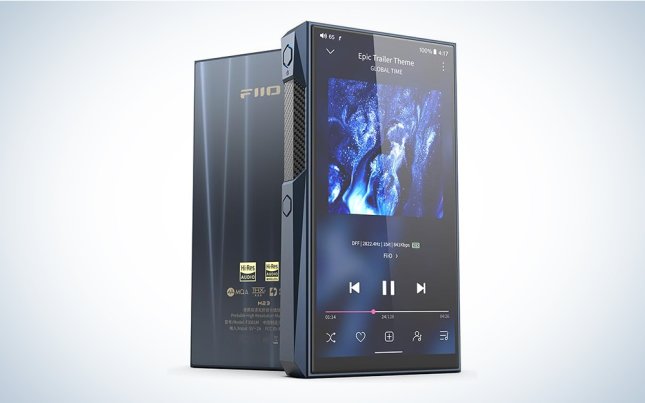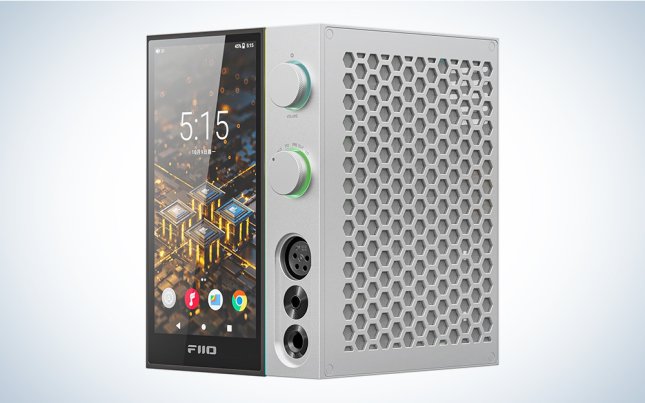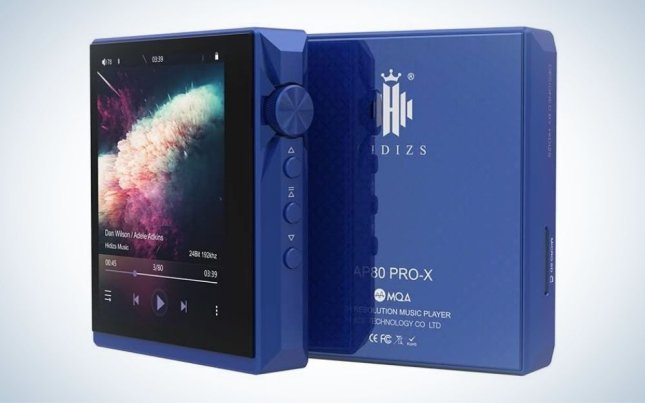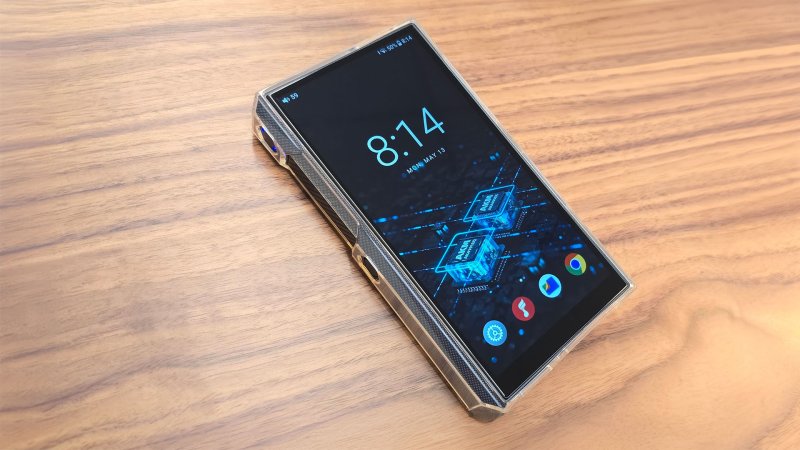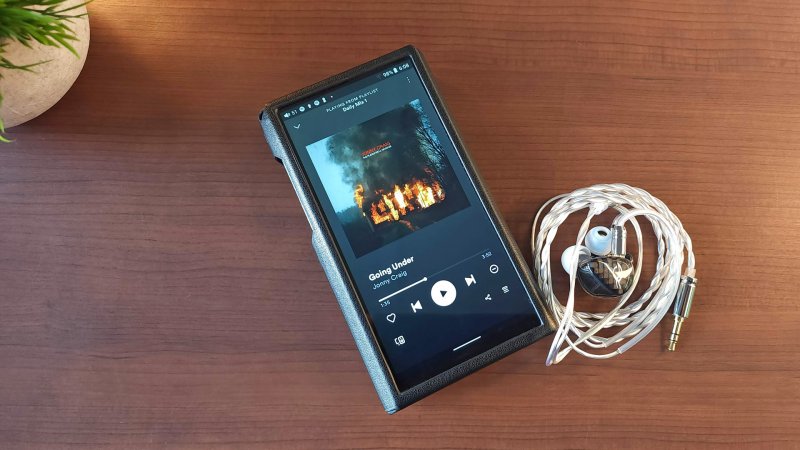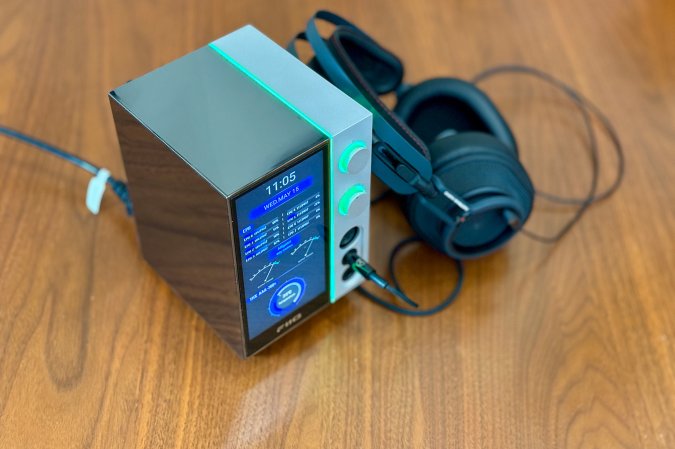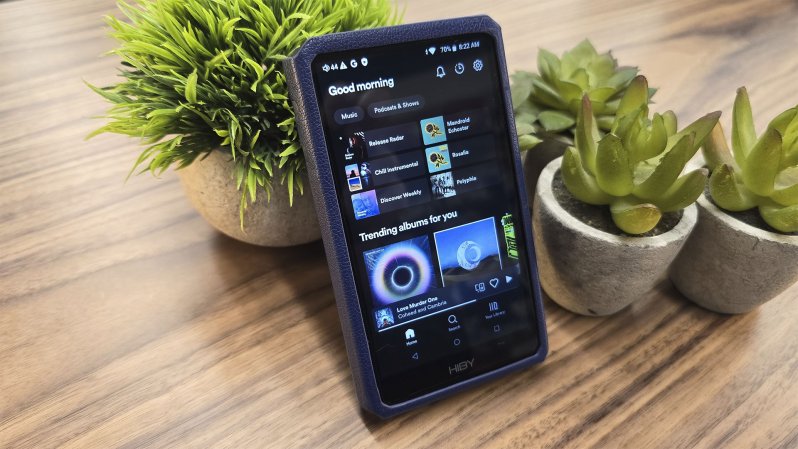We may earn revenue from the products available on this page and participate in affiliate programs. Learn more ›
Ask any audiophile, and they’ll tell you the same thing: premium sound quality still comes from wired headphones—and if you want to get the most out of your investment while out and about, you should look into DAPs, a.k.a. digital audio players. With the headphone jack’s death on smartphones, getting an optimized on-the-go listening experience isn’t as easy as it used to be. It doesn’t matter if you have access to lossless audio if you’re just going to degrade it using Bluetooth. If you’re looking for that old-school iPod Touch experience given fresh life with the latest high-resolution technology, there’s only one way to go: tap into a DAP like our best overall, the FiiO M23. Whether you’re looking for the most versatile portable player, a desktop music streamer that can be the centerpiece of a home setup, or the best budget device, these are the best DAPs for every type of user.
- Best overall: FiiO M23
- Best desktop: FiiO R9
- Best under $500: HiBy R5 Gen 2
- Best budget: Hidizs AP80 Pro-X
How we chose the best DAPs
Over my years working in tech journalism, I’ve developed a passion for great sound. As an apartment dweller until 2019, I was limited to in-ear monitors and headphones, so I skipped right over loudspeakers and dove deep into personal audio equipment. I’ve been lucky enough to test dozens of different headphones, earphones, and devices that drive them. I’ve learned and experienced far more than I ever expected to, but the depths of my audio geekery allowed me to develop a discerning eye to sort the stupendous from the snake oil.
For this article, I researched the major digital audio players released over the last several years. I began with an eye toward features and components: the on-paper specs that made certain options stand out from others. I then compared those early choices with real user impressions on audio enthusiast sites like Head-Fi and r/headphones, smaller communities like Facebook’s ChiFi Audio Reviews, and retailers like Amazon. This refined the list because what looks good on paper doesn’t necessarily translate into a great product. Finally, I relied on my own first-hand experience, as well as the pedigree of the brands producing each DAP.
The best DAPs: Reviews & Recommendations
These standalone devices have a sole purpose: playing music. Some portable music players do this with audio files you need to load yourself. Others come with operating systems (most often Android-based) and support streaming services like Spotify or TIDAL. They can also range widely in cost, some focusing on accessible budget pricing and others taking the form of genuine luxury items. However, they all strive to deliver the highest sound quality, exceeding what you could hope for from a smartphone and headphone adapter. If you’re on the hunt for an aural upgrade, we’re here to help and have collected top-tier options.
Even with those considerations in mind, settling on one of the best portable players can be confusing without doing lots of research—which is exactly what we’re here for. We’ve done the digging, so you don’t have to. Here are the best digital audio players available today that offer far more features than the MP3 players they call ancestors.
Best overall: FiiO M23
Pros
- Great balance of features and price
- Snappy performance
- Supports balanced and single-ended headphones
- High power output
Cons
- Slightly less battery than the last generation
- Rather bulky
Specs
- Price: $699.99
- Screen size: 5.5-inch HD (1440×720) IPS panel
- Connectivity: Balanced (2.5mm/4.4mm), single-ended (3.5mm), Bluetooth 5.0 (SBC/AAC/aptX HD/LDAC)
- Music streaming: Yes
- Output power: 1000mw per channel
- DAC: AKM AK419EQ + AKM AK4499EX DAC
- Battery life: 10.5 hours
Why it made the cut: The FiiO M23 is the successor to the M11Plus (our previous best overall pick) and offers major improvements without any increase in price. It’s a killer value.
The FiiO M23 is the successor to the M11Plus, released in 2021. That model was our pick for the best overall DAP, and the M23 one-ups it in more ways than one. It’s more powerful, more stylish, has a better DAC, global EQ, and more, all without raising the price.
If you’re looking for the best balance of price and features, the M23 is easily the best pick right now under $1,000. In fact, you could easily spend more and get less. This digital audio player massively increases the power from the last generation. Its total output is an impressive 1000mW, enough to drive even the most demanding headphones. Because it has multiple gain modes, it works just as well with sensitive in-ear monitors.
This model also comes with enhanced components for better audio than ever before. FiiO is again working with AKM, one of the world’s premier manufacturers of digital-to-analog converters, following an unfortunate fire that limited its production. The M23 uses the same combination of dual DACs found in FiiO’s high-end K9 desktop DAC/amp and Q15 portable DAC: the AK4191EQ and AK4499EX. These DACs can reproduce audio up to 32-bit, 384kHz, and DSD up to DSD256. It also comes with AKM’s new DWA Routing Technology to decrease any potential background noise for improved dynamic range.
Its amplifier circuitry is also improved. While the M11Plus utilized a THX AAA 78 amplifier, the M23 features the upgraded THX AAA 78+, opening the door to its higher power output. THX’s AAA amplifier series is renowned for its incredible cleanness. Zero hiss, zero background noise, and utter neutrality describe its sound profile. This DAP will not color your listening experience unless you take advantage of its system-wide EQ.
And since it runs Android, you’ll also have access to all of your favorite streaming apps, including Spotify, TIDAL, Qobuz, and more. Its Snapdragon 660 processor is unchanged from the last generation and is admittedly getting long in the tooth. However, music listening and web browsing are still responsive enough to deliver a satisfying experience. You can get more power and features if you pay more, but in most cases, it’s well into the realm of diminishing returns beyond the M23. Just like the M11Plus, it’s a fantastic value that balances sound quality, features, responsiveness, and, most importantly, price with ease.
Suppose you don’t need more power and the latest chipsets. In that case, there are still people selling the FiiO M11 Plus (shown above), as well as the Chinese personal audio specialist’s even more budget M11S for those looking to really stretch that performance-to-price ratio. On the other end of the spectrum, FiiO offers a fancier flagship worth exploring if you only own hard-to-drive summit-fi headphones—the $1,799 flagship M17, a handheld that packs the power of a desktop amp into a transportable form.
Best desktop: FiiO R9
Pros
- Fantastic connectivity
- Works great for headphones or full speakers
- Convenient touch interface
- Massive power output
Cons
- Large footprint
- Not portable
Specs
- Price: $1,499.99
- Screen size: 6-inch IPS FHD (2160 x 1080) portrait panel
- Connectivity: Balanced (4.4mm/XLR), single-ended (6.35mm), Bluetooth 5.1 (AAC/SBC/aptX/aptX HD/LDAC/LHDC), RCA, Optical, Coaxial, HDMI in, HDMI out (ARC), USB-A, USB-C, 100M Ethernet,
- Music streaming: Yes
- Output power: 7300mW
- DAC: Dual ES9038Pro DACs
- Battery life: N/A
Why it made the cut: This flagship media streamer transcends traditional players by becoming a desktop device, complete with a powerful amp, great DAC, and tons of connectivity.
The FiiO R9 is one of the more unique digital audio players you can buy. It’s a hybrid, an aluminum monolith with colorful LED accents that blurs the lines between a traditional audio player and an exceptionally powerful, high-resolution DAC/amp. This network player features a six-inch touchscreen (shown above with its protective shipping panels still intact) and an Android 10 operating system that can connect to the internet for streaming services and apps, like most portable players, but it’s not designed to be portable. The media streamer is made to live on your desktop near your computer or wherever you plan to listen to music, and it will connect to and drive just about anything—including your soundbar (via ARC), a preamp/AV receiver, or an existing powered speaker setup. And—with a trio of headphone outputs (two of them balanced) delivering punchy lows, textured mids, and quick, controlled transients—it ensures that any cans can.
While it might seem counterintuitive to put an Android player on your desktop, the magic of the R9 lies in how well-designed it is. Just like portable players, having a separate device dedicated purely to music is naturally appealing for its dedication to pristine sound quality. Being able to tap and swipe instead of changing windows (and destroying your workflow) winds up feeling more convenient and intuitive. And if you prefer to set it up away from physical sources or use it when the Wi-Fi router is down, you can simply stream to it from your smartphone using your choice of high-res codecs. We already enjoy using an ASUS Zenfone 10 when testing Bluetooth devices (because what is an inexpensive, easily pocketed Android smartphone if not a DAP itself), and the R9 experience is equally intuitive and efficient, but with added levels of All-to-DSD and Parametric EQ music-first processing. Conversely, you can use the R9 to connect to AirPlay devices (like an iPhone) as a source, as well as Bluetooth devices as a destination.
FiiO took the “kitchen sink” approach to the R9, and it’s a better product because of it—offering both a polished look and sound. If there’s a feature you can think of, it probably has it. Between its tremendous power and connectivity, as well as its dual top-tier ES9038Pro DACs and eight-channel THX-788+ amplifier (featuring five levels of gain), it’s designed with circuit boards full of discrete components that allow it to be the centerpiece of your home listening experience. You can connect a Blu-ray player for advanced resolution audio via HDMI, play hi-rez downloads and rips off a MicroSD card, use the device as an endpoint to access a Roon music server, or opt for (semi-)analog with a turntable that offers USB output. And that’s just some of the I/O. Really the only thing the R9 can’t do is power passive speakers. If the R9 sounds appealing but it’s out of your budget, the FiiO R7 is a great alternative. Coming in at around half the price, its screen is small, it drops power output to a still respectable 3.6 watts, and it loses the HDMI ports but maintains all of the same appeal otherwise. Both the R7 and R9 are destined to impress with linear performance in versatile packaging.
Still consider a handheld DAP the best splurge for you and open to splashing out a few thousand to lug around some luxury? If it’s refined industrial angles you crave, the Astell&Kern A&ultima remains one of the most distinctive DAP lines with the best design, and the SP3000 continues the company’s tradition of high-resolution listening and the best high-end builds.
Best under $500: HiBy R5 Gen 2
Pros
- Unique sound tuning that’s very accessible
- Good power output
- Good connectivity
- Compact and convenient size
Cons
- Slower processor
- Aging specs
Specs
- Price: $349.99
- Screen size: 4.7-inch (1280×720) IPS panel
- Connectivity: Balanced (2.5mm/4.4mm), single-ended (3.5mm), Bluetooth 4.2 (SBC/AAC/aptX/aptX HD/UAT/LDAC),
- Music streaming: Yes
- Output power: Up to 475mW
- DAC: Dual ES9219C DACs
- Battery life: 35 hours (10 hours in Class A mode)
Why it made the cut: The HiBy R5 Gen II is a killer value, combining good power output, connectivity, and features for well under $500.
If you’re looking for a quality DAP that won’t break the bank, the HiBy R5 Gen II is well worth considering. At only $349 and sometimes less (we’ve seen it as low as $279 after a $70 instant coupon), this player offers audiophile-grade sound quality and some truly fantastic features. It combines support for up to 32-bit/768kHz files with an impressively low 130dB signal-to-noise ratio for complete clarity across its 2.5mm, 3.5mm, and 4.4mm connections. If you’d rather stream your music, it also supports MQA so you can enjoy TIDAL to its fullest or simply download Spotify and other streaming apps through the Google Play Store.
The R5 Gen II is compact, with a size that’s pocketable but still easy to use. Despite its stature, it offers a surprising amount of power with up 320mW in its default mode or 475mW in Class A mode. The first setting nets you the best battery life at 28 to 35 hours, while Class A mode instantly enhances the sound with added fullness and headroom.
What’s especially nice about the R5 is HiBy’s unique approach to equalization. Rather than rely on confusing frequency band sliders like most EQs, the R5 uses sound characteristics to describe what you’re adjusting. Want your sound brighter and more detailed or bassy and dark? There’s a slider for that. Want more texture and detail in the bass or vocals to be more forward or back in the mix? There are sliders for those too and more besides. It’s a much more accessible and fun approach to customizing your sound. The R5 isn’t without its downsides. The technology driving it and its OS version are getting old, so you shouldn’t plan on much more than listening to music or checking the occasional email with this device. But as a DAP, it’s responsive enough, fun, and sounds great—making it our best value pick.
Best budget: Hidizs AP80 Pro-X
Pros
- Supremely pocketable
- Good output power at this price
- Very user-friendly EQ
- 8x MQA decoding
- Built-in step counter and ebook reader, if you want to leave your smartwatch and Kindle at home
Cons
- Plays local files only in normal mode
- Comparatively low battery life
- No onboard storage
Specs
- Price: $189.99
- Screen size: 2.5-inch
- Connectivity: Balanced (2.5mm), single-ended (3.5mm), Bluetooth 4.1 (including AAC, aptX, LDAC, UAT codecs)
- Music streaming: No
- Output power: 190mW (balanced), 70mW (single-ended)
- Battery life: 9 hours (balanced), 13 hours (single-ended)
Why it made the cut: The Hidizs AP80 Pro-X can’t stream music, but it offers a highly customizable sound with lots of versatility.
The Hidizs AP80 Pro-X is unlike any other DAP on this list and is excellent value for its budget price. Coming in at $189, it is the only portable music player we feature that is unable to connect natively to major streaming services. But don’t let that fool you, as the AP80 Pro-X has a lot going for it that makes it well worth considering for music lovers on a budget.
Much of the magic of the AP80 Pro-X comes from its simplicity. It runs the HiBy OS, which does not have access to the Google Play Store but is fast and responsive, avoiding the pitfall of sluggishness plaguing so many digital audio players. It can accept MicroSD cards up to 512GB, holding up to a couple of thousand albums (including files up to 32-bit/384kHz PCM and DSD256). And it delivers those files with plenty of power across its 3.5mm single-ended (70mW) and 2.5mm balanced (190mW) connections.
If you want to listen to streaming services, you’ll need a smartphone or computer. When connected to an internet-enabled source, the AP80 Pro-X can act as a DAC, receiving that audio and sending it through (complete with 8x MQA decoding) to your headphones. It functions similarly to a dongle DAC or a wireless Bluetooth receiver (supporting AAC, aptX, LDAC, UAT codecs) but with all the features and enhanced sound quality of this much more sophisticated player. It also offers expansive sound customization with sliders dedicated to specific descriptors, like “bass extension” and “note thickness.” It’s a unique, user-friendly touch other DAP manufacturers could learn from.
At $189, the AP80 Pro-X offers quite a lot, but it’s not without its sacrifices. It doesn’t come with onboard storage to begin uploading your files immediately. The battery life is also only so-so. But with a one-hour complete recharge time, downtime shouldn’t be much of an issue, and the AP80 Pro-X (shown above with the equally approachably priced MP145 planar-magnetic IEMs) offers far, far more than the cheap digital music players of old and lets you relish all the details.
Things to consider before buying one of the best DAPs
Like most things within the audio hobby, choosing the right DAP isn’t as simple as finding what’s popular and assuming it will work for you. Prices scale into thousands of dollars; unsurprisingly, those expensive products tend to get rave recommendations. Based on positive feedback alone, you might assume you must spend $1,000 for a great experience. Instead, the much wiser choice is to work backward from the features you need and find the best digital audio player that fits your budget. Here’s what to look for before committing to a purchase:
Connectivity
The first thing to consider with any DAP is its connectivity options. Some DAPs are limited solely to single-ended (standard 3.5mm) connections. Others offer 4.4mm or 2.5mm balanced connections—ports that split the signal into left and right channels for reduced distortion, improved clarity, and increased power delivery. Even if your current headphones use a standard 3.5mm jack, it’s worth considering whether a balanced earphone may be in your future. Since balanced outputs tend to offer more power, it is a useful option if you’re listening to harder-to-drive headphones.
One important thing to remember is that, due to their size, the best hi-res players typically lack support for the large 6.35mm jacks common to over-hear headphones. Using a DAP with cans like these is still possible, but you’ll need an adapter to make the connection. This flexible option from Sennheiser is an excellent choice and comes in at just under $20.
Connectivity doesn’t stop at the wire, however. Some DAPs also support Bluetooth to send and/or receive audio, as well as Wi-Fi for higher-resolution/bandwidth audio. If you want your device also to drive true wireless earbuds or the best portable speakers, you’ll need to be sure it supports Bluetooth as a feature. It’s important to acknowledge that, while convenient, Bluetooth isn’t the highest-fidelity option. However, pairing earbuds and a DAP that supports the LDAC codec is a solid listening experience, and Snapdragon Sound with aptX Lossless, while on very few components currently, has potential.
Output power
Right up there with connectivity options is how much power the portable DAP can produce. This isn’t usually an issue for small, easy-to-drive in-ear monitors, but it is a major consideration if you’re considering over-ear headphones. Audiophile-grade cans often require the extra power of a dedicated headphone amplifier to sound their best, and a DAP that doesn’t produce enough power to drive them is bound to disappoint.
This information is usually found on the specification list for most players and is rated in milliwatts (mW) or volts RMS (VRMS). It is typically rated against a certain resistance measured in ohms: 70mw@32Ω, for example. The amount of output power can also vary between the balanced and single-ended (3.5mm) outputs. So, it’s important to consider which port you’ll be using and not just assume the highest possible output power is what you’ll be getting.
Since headphones have an incredibly wide range of power demands, offering specific advice without knowing which will be used is impossible. Generally, 50mW of output power is sufficient for most earphones. Headphones can be more demanding. To be safe, run your headphones through a headphone power calculator to find out exactly how much power output you should be targeting.
If you plan to listen to a mix of in-ear and over-ear headphones, consider looking for a DAP with high- and low-gain modes for less hiss and more fine-tuned volume adjustment. A very high-output player may work great for a demanding pair of audiophile headphones but could make listening to sensitive multidriver earbuds difficult with very touchy volume controls. Being able to swap between low- and high-gain modes can be game-changing to the versatility of a DAP.
Support for streaming services and file types
Digital audio players come in two varieties: simple music-file players and smart devices supporting online streaming. If you’re a die-hard fan of lossless audio with a deep catalog of hi-res audio files, you’ll probably be happy with a standard “dumb” DAP that has the sole job of making your music sound great.
If you’re a fan of TIDAL or Spotify, you’ll need a DAP that can connect to the internet and has a display capable of navigating these apps. That means running some version of Android and, usually, a more complicated and expensive device.
Smart audio players often feel like smartphones designed around playing music, which can be both good and bad (if you’re looking for that kind of convergence device, check out something with an upgraded integrated DAC/amp, like the ASUS ROG Phone 8 Pro). On the plus side, DAPs that support streaming services give you access to huge music libraries and the ability to pick up where you left off across different devices. The downside is that, since the focus is on audio quality, the actual computer side of the device is often several generations old, including the operating system. Many smart DAPs feel sluggish compared to similarly priced smartphones.
The other thing to consider is what file formats the device can play back. To stream the highest quality tracks from TIDAL, your DAP must support decoding those files. TIDAL’s top streaming tier features FLACs that use a high-resolution compression algorithm that only some players can fully decode, usually at an additional cost. Likewise, if you’re playing local files, you’ll want to be sure the device supports the format of your library (FLAC, ALAC, DSD, WAV, etc.).
Battery life
Finally, the last thing to consider when purchasing a DAP is how long you can expect it to play between recharges. Somewhat counterintuitively, the fancier DACs often offer worse battery life due to their large screens, Android operating systems, and more powerful digital signal processing options/amplifier output. Any DAP worth investing in will last at least through a workday of listening. If you don’t mind plugging in overnight, this will likely be sufficient.
Along with this, look closely at how long the player takes to recharge. The Hidiz AP80 Pro-X comes in on the low end for battery life but takes only an hour to fully recharge, which means a quick plug-in throughout the day will likely close the gap in usability for extended listening sessions. If you anticipate having to plug in, also check if the device can still be used while charging.
FAQs
The acronym “DAP” stands for Digital Audio Player. These standalone devices aim to play your music back at the highest quality. While many audiophile products pair with a smartphone via USB, DAPs remove your phone from the equation entirely. Instead, they’re entirely built around sound quality, including components and designs engineered to maximize the listening experience.
The best-known DAP is probably the original Apple iPod. Since those small MP3 players, many listeners have become content with the ease of listening wirelessly through their smartphones. This isn’t a great solution for audio enthusiasts and music fans with favorite wired headphones. A DAP can be the perfect answer for them, creating a portable hi-fi system that allows them to carry a top-tier listening experience everywhere they go.
If you love music, it makes sense to have a device dedicated to it. While it’s certainly possible to listen through your smartphone, it’s an incredibly complex device trying to do multiple things simultaneously. Audio performance is important to smartphone engineers, but it’s hardly the top concern when compared to everything else a modern smartphone is responsible for: operating system performance, multiple radios, adaptive refresh rates, complex camera systems, running apps at once, notifications, and, of course, call quality. This is also reflected in the components and, well, the lack of a headphone jack.
A DAP, on the other hand, is designed entirely around sound quality. They often feature high-quality DACs (digital-to-analog converters) and higher output power. These improved components make an audible difference in sound quality, improving clarity and dynamic range and allowing it to drive a wide range of headphones. Like a desktop computer, removing the audio processing from the electrically noisy circuit board of a smart device can also remove a potential source of interference.
Ultimately, one of the key reasons many buy a DAP is to invest in a portable “foundation” for their listening experience. Investing in a dedicated portable audio player is rarely “necessary” in this day and age, the same way it’s not necessary to buy the $899 Bluesound SOUNDBAR+ when you can buy one of the best soundbars under $500 and get many of the same features—unless you’re specifically slowly working up to a full music-centric wireless surround sound system. Rather than purchase a tethered DAC that will let your phone do the heavy lifting, a DAP becomes a touchstone to the audio hobby that’s personal to each listener.
Digital audio players span the gamut in price. Basic Bluetooth MP3 players can be found on Amazon for close to $50. Others, like the premium Astell&Kern A&ultima SP3000, can cost several thousand dollars. It’s not usually necessary to spend an exorbitant amount of money on a digital audio player. Still, they can become quite expensive, easily reaching $3,000-$5,000 with more advanced features and luxuries like copper enclosures.
As a rule, DAPs that support Android will be more expensive than those that do not. Likewise, DAPs that support more connectivity options, like balanced versus just single-ended headphones, will also be more expensive. Within this framework, there can be a wide range of prices, so it’s important to look at what features you need and desire most and choose the option that works for you.
It’s important to remember that hi-fi can be an expensive hobby. The cost ceiling stretches far higher than most listeners would ever consider spending. Just because a DAP is twice as expensive does not mean it’s twice as good.
Final thoughts on the best DAPs
- Best overall: FiiO M23
- Best desktop: FiiO R9
- Best under $500: HiBy R5 Gen 2
- Best budget: Hidizs AP80 Pro-X
Deciding on a DAP can be intimidating. With prices extending into hundreds of dollars and beyond, the pressure to make the right decision is high. But, with a focus on features, it’s possible to find the right fit that will let you enjoy your music to the fullest on the go. The best DAPs provide room to grow and explore the hobby even further. With care, they even tend to retain resale value, giving you a one-up on that next inevitable upgrade.
